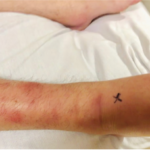Reactive arthritis is classically associated with an infectious etiology, such as Salmonella, Yersinia, Campylobacter, Chlamydia or gonorrhea. Clostridium difficile is a rare, and recently recognized, causative agent for this condition.1
Case Presentation
The patient is a 21-year-old man with a past medical history significant for hereditary spherocytosis and Crohn’s disease, complicated by an anorectal fistula, and was receiving monthly infusions of infliximab for his Crohn’s disease. He presented to the emergency department of an outside hospital with a five-day history of pain in multiple joints.
He was initially admitted to an outside hospital for concern of septic arthritis of the knees and was given empiric antibiotics, then transferred to our hospital for evaluation by a rheumatologist due to concerns for inflammatory bowel disease-related arthritis.
The patient initially developed left-sided rib pain, which was worsened by deep inspiration and improved with hot showers and stretching movements. He also noted left-sided hip and groin pain, bilateral wrist and hand pain, and knee pain associated with knee swelling, which significantly limited his range of motion. He denied any eye pain, eye redness, abdominal pain, tenesmus and hematochezia, but admitted to having diarrhea, which had not changed from prior to starting infliximab therapy. He denied rashes, mucosal ulcers, back pain, Raynaud’s phenomenon, dysuria or penile ulcers or discharge, recent insect bites or tick bites. His social history was unremarkable.
He was diagnosed with Crohn’s disease at the age of 16; his course was complicated by development of an anorectal fistula. He had been on and off steroids due to nonadherence. He was started on infliximab for persistent diarrhea. His last (fourth) dose was 10 days prior to his presentation. He stated that his chronic diarrhea had not changed from his baseline.
The patient’s initial vital signs showed low-grade fever and tachycardia. His physical examination was significant for painful passive movement of both wrists and the left hip, with limited flexion of the lower back, without swelling or tenderness of the knees.
His laboratory workup included a complete blood count, which showed mild elevation of his white blood cell count, normal comprehensive metabolic profile, erythrocyte sedimentation rate of 4 mm/hour, C-reactive protein of 89.2 mg/L initially, ferritin 97 ng/mL, negative hepatitis A, B and C screen, negative anti-nuclear antibodies, uric acid of 3.3 mg/dL, normal creatine phosphokinase and normal urinalysis. Rheumatoid factor was absent. Blood cultures and urine testing for gonorrhea and chlamydia were negative. Hip and sacroiliac joint X-rays were unremarkable.
Given his persistent diarrhea, a C. difficile stool polymerase chain reaction test was performed and yielded a positive result. His joint pain was, thus, attributed to reactive arthritis secondary to C. difficile infection; he was started on a course of oral vancomycin and was discharged home with resolution of his symptoms.


